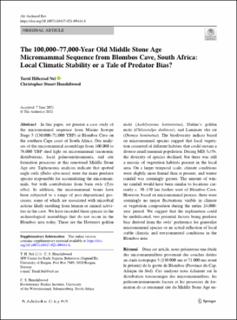| dc.contributor.author | Nel, Turid Hillestad | |
| dc.contributor.author | Henshilwood, Christopher Stuart | |
| dc.date.accessioned | 2021-08-17T08:46:40Z | |
| dc.date.available | 2021-08-17T08:46:40Z | |
| dc.date.created | 2021-07-19T13:49:48Z | |
| dc.date.issued | 2021 | |
| dc.identifier.issn | 0263-0338 | |
| dc.identifier.uri | https://hdl.handle.net/11250/2768702 | |
| dc.description.abstract | In this paper, we present a case study of the micromammal sequence from Marine Isotope Stage 5 (130,000–71,000 YBP) at Blombos Cave on the southern Cape coast of South Africa. Our analyses of the micromammal assemblage from 100,000 to 76,000 YBP shed light on micromammal taxonomic distributions, local palaeoenvironments, and site formation processes at this renowned Middle Stone Age site. Taphonomic analyses indicate that spotted eagle owls (Bubo africanus) were the main predator species responsible for accumulating the micromammals, but with contributions from barn owls (Tyto alba). In addition, the micromammal bones have been subjected to a range of post-depositional processes, some of which are associated with microbial actions likely resulting from human or animal activities in the cave. We have recorded three species in the archaeological assemblage that do not occur in the Blombos area today. These are the Hottentot golden mole (Amblysomus hottentotus), Duthie’s golden mole (Chlorotalpa duthieae), and Laminate vlei rat (Otomys laminatus). The biodiversity indices based on micromammal species suggest that local vegetation consisted of different habitats that could sustain a diverse small mammal population. During MIS 5c/5b, the diversity of species declined, but there was still a mosaic of vegetation habitats present in the local area. On a larger temporal scale, climate conditions were slightly more humid than at present, and winter rainfall was seemingly greater. The amount of winter rainfall would have been similar to locations currently c. 50–150 km further west of Blombos Cave. However, based on micromammal proxies, there were seemingly no major fluctuations visible in climate or vegetation composition during the entire 24,000-year period. We suggest that the explanation could be multifaceted, two potential factors being predator bias derived from the owls’ preference for generalist micromammal species or an actual reflection of local stable climatic and environmental conditions in the Blombos area. | en_US |
| dc.language.iso | eng | en_US |
| dc.publisher | Springer | en_US |
| dc.rights | Navngivelse 4.0 Internasjonal | * |
| dc.rights.uri | http://creativecommons.org/licenses/by/4.0/deed.no | * |
| dc.title | The 100,000–77,000‑Year Old Middle Stone Age Micromammal Sequence from Blombos Cave, South Africa: Local Climatic Stability or a Tale of Predator Bias? | en_US |
| dc.type | Journal article | en_US |
| dc.type | Peer reviewed | en_US |
| dc.description.version | publishedVersion | en_US |
| dc.rights.holder | Copyright The Author(s) 2021 | en_US |
| cristin.ispublished | true | |
| cristin.fulltext | original | |
| cristin.qualitycode | 2 | |
| dc.identifier.doi | https://doi.org/10.1007/s10437-021-09444-8 | |
| dc.identifier.cristin | 1922093 | |
| dc.source.journal | African Archaeological Review | en_US |
| dc.relation.project | Norges forskningsråd: 262618 | en_US |
| dc.identifier.citation | African Archaeological Review, 2021. | en_US |

